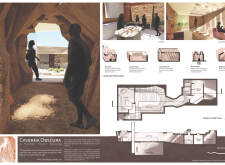5 key facts about this project
Caverna Obscura is located near the Grand Canyon in Flagstaff, Arizona. The design focuses on the relationship between light and shadow, taking inspiration from themes in Plato's Allegory of the Cave. It creates an environment that not only serves as a home but also allows residents to connect with the natural surroundings through changing light patterns.
Architectural Concept
The concept of Caverna Obscura is centered around the duality of light and shadow. This design encourages a conversation between these two elements throughout the space. Natural sunlight functions like a sundial, guiding daily routines and activities. Ambient light creates distinct atmospheres in different areas, balancing functionality and visual appeal.
Spatial Configuration
The dwelling features a layout divided into functional zones, such as a kitchen, living room, and private areas. Each of these spaces is enhanced by light wells and skylights, which introduce natural light and fresh air. The kitchen has a main light well and a smaller one behind the cabinets. The living room benefits from a skylight, allowing light to shift dramatically throughout the day.
Material Context
Rough stone walls are a significant material choice in the design. This connects the interior to the nearby landscape, creating a tactile warmth that enhances the experience of living in the space. The contrast between the textured stone and clean architectural lines provides a visual balance, reflecting both the environment and modern design principles.
Design Details
One noteworthy feature is the courtyard, which includes a canvas cover to protect against blowing sand while offering shade. This thoughtful insertion expands indoor living into outdoor space, allowing for relaxation and gatherings in nature. Visual privacy is also carefully planned, utilizing blocks that let in light without compromising seclusion.
The design of Caverna Obscura illustrates a thoughtful balance of light and shadow, where the home serves not just as shelter but as a way for residents to engage with the natural world surrounding them.



















































